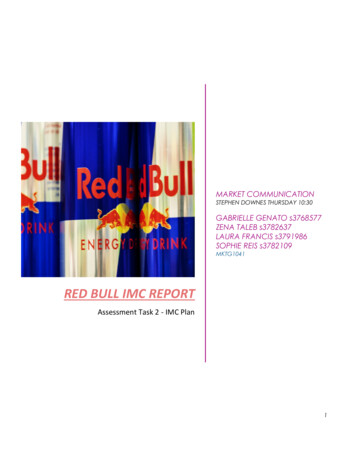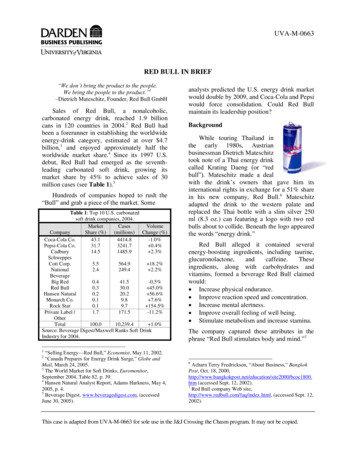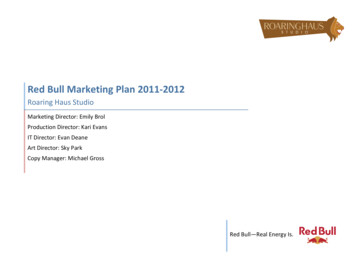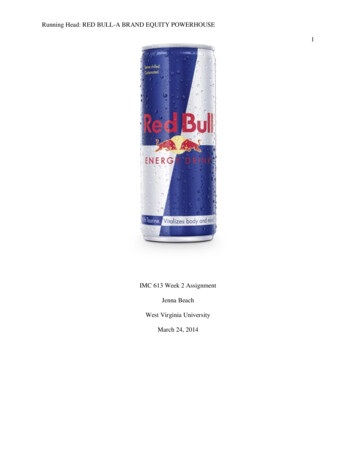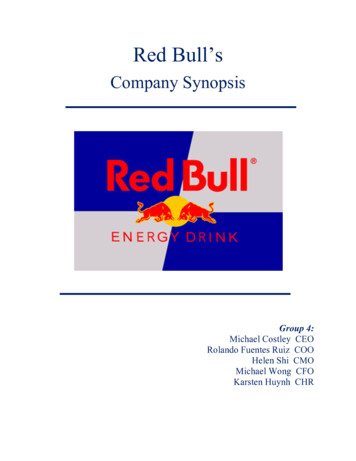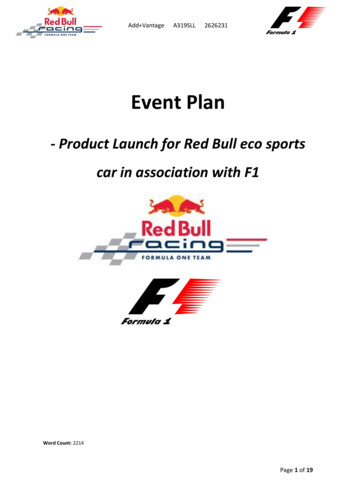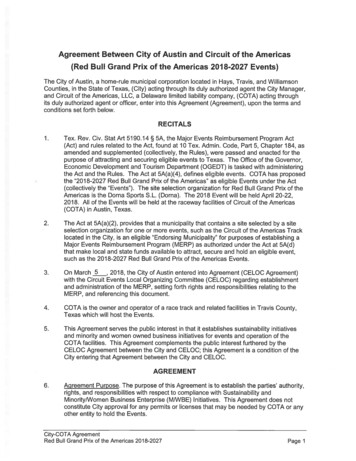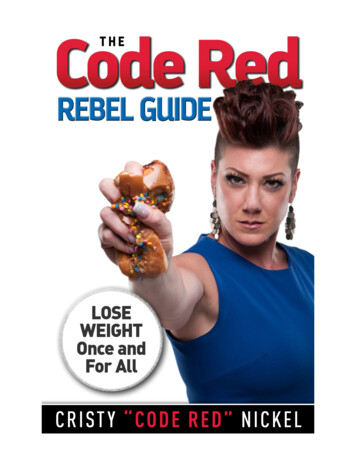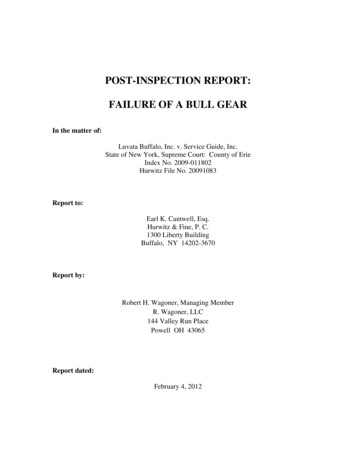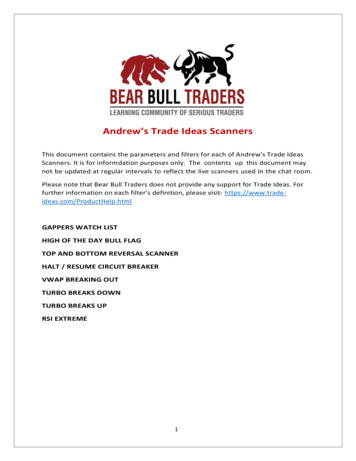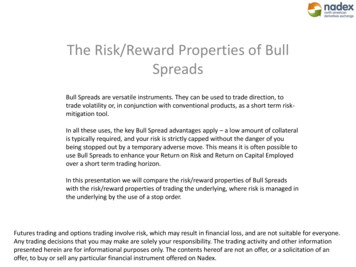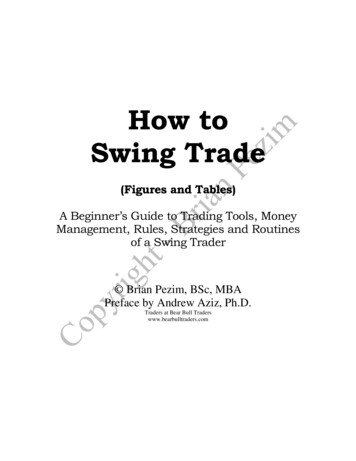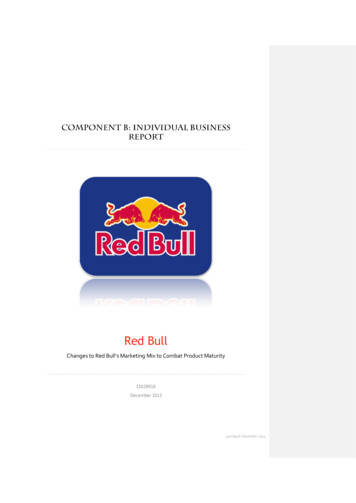
Transcription
Red BullChanges to Red Bull’s Marketing Mix to Combat Product Maturity13028916December 201313028916 December 2013
Red Bull 20. Executive SummaryDr Philip Kotler defines marketing as; “1) Marketing is the process by which an organization relates creatively,productively, and profitably to the marketplace. 2) Marketing is the art of creating and satisfying customers at a profit. 3)Marketing is getting the right goods and services to the right people at the right places at the right time at the right pricewith the right communications and promotion.” (Kotler, 1991)This report seeks to provide an outline of how to achieve this by prioritising and facilitating the Critical Success Factorsoutlined in component A of the Understanding the Market Process module, by adapting Red Bull’s marketing mix. Theinformation for the analysis is drawn from a wide variety of academic sources, as well as industry reports andperiodicals.Red Bull currently operates within the energy sector of the functional drink market, with a recent expansion intoenhanced water. A functional drink defined is a product that is non-alcoholic and includes ingredients such as herbs,vitamins, minerals, amino acids or additional raw fruit or vegetables. It often claims to provide specific health benefits.Examples of such drinks include sports and performance drinks, energy drinks, ready to drink (RTD) teas, enhancedfruit drinks, soy beverages and enhanced water (Mintel, 2013) (Kalra, 2003).There is a niche in the Neutraceutical market for a functional drink that includes one of your 5 a day and additionalvitamins and minerals, as well as the addition of the physiological element of caffeine and Taurine. Neutraceutical is aportmanteau of nutrition and pharmaceutical coined by Dr Stephen DeFelice in 1989 (Kalra, 2003).It is advisable that Red Bull extends its range to include a speciality product, with unique characteristics which targetedconsumers would specifically purchase. Red Bull needs to act quickly and decisively, to fill the gap in the Neutraceuticalmarket, to counteract the market maturity and aging population.Comment [TG1]: Excellent summary!
Red Bull 3CONTENTS0.Executive Summary21.Introduction41.1 Critical Success Factors41.2 Company Overview41.3 Economic Performance42.Red Bull’s Marketing Mix62.1 Product62.2 Promotion72.3 Price92.4 Process & Place102.5 People & Proof103.Conclusion104.References11FIGURESFigure 1: Red Bull vs. World Performance 2007 – 2012.4Figure 2: The Stages of the Product Cycle . 5Figure 3: The Product Marketing Mix for Red Bull. 6Figure 4: Selected types of products considered to be healthy, by age, September 2013. 7Figure 5: Age pyramid in 2000 and 2050. . 7Figure 6: Types of products considered to be healthy, September 2013, Based on 2,000 internet users aged 16 .8Figure 7: The Integrated Marketing communications . 9Figure 8: Comparison of Actimel and drinking yoghurt. . 10
Red Bull 41. IntroductionThe purpose of this report is to prioritise and facilitate the Critical Success Factors (CSF). The report outlines thecurrent performance of Red Bull, the marketing mix, and products, as well as the amendments required to achieve theCSFs.1.1 Critical Success FactorsBased on an in-depth macro & micro and TOWS analysis of Red Bull, the following critical success factors have beenprioritised as they are deemed essential for Red Bull to adapt to remain competitive in the functional drinks market. Continue to combat product maturity, and reduction of the core demographic, by expanding the drinksrange to aim at the growing 25 demographic.Negate the effects of a growing more health conscious market (Annunziata & Vecchio, 2011) (Siró, 2008)(Lau, 2013).To continue comparing Red Bull’s caffeine content with content of everyday food such as tea and coffeeto position it as a viable healthy alternative.1.2 Company OverviewRed Bull GmBH is a Private company, registered in Austria, employing 8,966 staff in 165 countries as of 2012(Euromonitor International, 2013). The company can be split into two major arms; Soft Drinks & Other Companies. Thesoft drinks sector is subdivided into Red Bull Cola & Carpe Diem and the Energy Brands. (Euromonitor International,2013).1.3 Economic PerformancethRed Bull’s previous focus on the Energy Drinks Market alone has resulted in its ranking 9 in the global off-trade softdrinks market in 2012, with 0.2% market share (Euromonitor Profiles, 2013), and 9.8% of the Global Energy DrinksMarket (MarketLine, 2013).The largest growing market is currently the Neutraceutical drinks market with growth of between 8% (MarketLine,2013) and 14% year-on-year (MarketLine Advantage, 2013).Following the 2008 economic downturn, Red Bull has failed to regain previously enjoyed growth (Euromonitor Profiles,2013) in the Energy Drinks market.Figure 1: Red Bull vs. World Performance 2007 – 2012Source: (Euromonitor Profiles, 2013)Comment [TG2]: Here you arereferring to Red Bull’s ‘unhealthy’ image, Iassume?
Red Bull 5The financial and market data indicates that in developed countries Red Bull is entering the fourth stage of the productcycle, maturity (Bains, 2011), as the product is well established in the market, though no longer enjoying rapidlyincreasing sales. In time sales will start to decline.Figure 2: The Stages of the Product CycleSource: (Bains, 2011) (Rohn Group, Sandiego State University, n.d.)Comment [TG3]: The can of drink asopposed to the organisation, I assume?
Red Bull 62. Red Bull’s Marketing Mix2.1 ProductRed Bull sells not only an energizing energy drink, but also a lifestyle and sense of quality and style. The highlydistinguishable branding makes it instantly recognizable.PotentialAugmentedRed Bull‘Wings’ TeamMotto “it gives youwings”ActualA range of flavoursBrand loyaltyCoreBrandcoloursThirstQuenchingEnergyThe Red BullextremeCarbonatedsportCaffeinatedContentDrinkA connection with anunobtainablelifestyleRecognisable brandnamePick-me-upQuality &Brand’s‘stylish’, highoctane imageEnergy BoostInstantly recognisable canConsumerCare ContactnumberBrandAmbassadorsSportsSponsorshipA connection to sports and events thatpush boundariesFigure 3: The Product Marketing Mix for Red BullSource: (Armstrong, 2012)It is advisable that Red Bull extends its range away from the convenience products it currently produces, to a specialityproduct (Armstrong, 2012), with unique characteristics which a significant group of buyers would be willing to make aspecial effort to purchase.There are no Neutraceutical products on the market that combine a healthy vegetable juice with fortified minerals andvitamins along with caffeine and Taurine (GMI/Mintel, 2013) (Mintel, 2013) (Mintel Group Ltd, 2013) (MarketLine,2013). Research shows that these qualities, combined with labels as depicted in (Fig. 3), are main decision factorswhen purchasing a product, in addition to the absolute requirement of a specific health benefit (Bleiel, 2010) . The newcore product (Armstrong, 2012) (Bains, 2011), will be marketed with the main focus on the product being an energisinghealthy drink which promotes quality and prevention of lifestyle related illness.Comment [TG4]: A valuable addition toyour report.
Red Bull 7Figure 4: Selected types of products considered to be healthy, by age, September 2013Source: (GMI/Mintel, 2013)Despite a large number of recent studies and governmental organisations determining Red Bull and caffeine to be safein moderation (British Soft Drinks Assosciation , 2010) (Carvey, 2012) (Food Standards Agency, 2012) (Yamakoshi,2013) (de Haan HA, 2012) , the brand is yet to overcome the perception caused by previous research (Chad J. Reissig,2009) (Marczinski, 2006). It is essential that Red Bull secures the success of the new product by marketing its healthbenefits to ensure that the product is incorporated into buyers’ daily routine consumption and ongoing purchase(Bleiel, 2010), in addition to expanding the education of the current customers.2.2 PromotionRed Bull‘s existing well-developed marketing strategy, which uses a combination buzz marketing, sponsorship and TVand print advertising ( Red Bull GmbH, 2012), is aimed at 18 – 25 year olds males. This approach works well to drivehome the high octane and adrenaline fuelled message ( Red Bull GmbH, 2012), however is failing to capture thegrowing demographic of over 25s, as well as female consumers (Mintel Group Ltd, 2013).Figure 5: Age pyramid in 2000 and 2050.Source: (Bleiel, 2010)This is due to the perceived unhealthy ingredients, and high sugar levels. Additionally, in a number of tests energydrinks have been shown to be too sweet (Mintel Group Ltd, 2013), which also deters the impulse purchaser, who is notlooking for the physiological effects.
Red Bull 8Figure 6: Types of products considered to be healthy, September 2013, Based on 2,000 internet users aged 16 Source: (GMI/Mintel, 2013)To the consumers who are typically the more health aware and less price sensitive 25 market (Bleiel, 2010) (Lau, 2013)(Siró, 2008), such as the newly married and long-term cohabiting life-cycle and beyond (Bains, 2011), it is essential thatthe marketing mix appeals to their physiological criteria. This demographic is the largest purchaser of functional foodsand drinks which provide such, such as added vitamins and calcium, to stave off age and lifestyle related diseases(Bleiel, 2010)Red Bull introduced the Carpe Diem Brand to Austria and Switzerland as a trial to increase share in the Soft Drink andhealthy drink markets (Carpe Diem GmbH & Co KG, 2012). However Red Bull has not gone far enough to capture thisgrowing market.Red Bull is currently engaged in a variety of promotional activities (Euromonitor International, 2013), and has anintegrated marketing communications strategy. To successfully market and validate the functional properties andhealth benefits of the new product, it should be featured on health blogs websites and news and in the general media.The brand operates under an oligopolistic competition model (Armstrong, 2012), which is highly sensitive to thepricing and marketing strategies of its competitors. The new Neutraceutical range will exist in a pure monopolisticmodel (Armstrong, 2012), where the market consists of many buyers and a single producer.
Red Bull 9AdvertisingTV, Print, Billboard, Radio,Social media & internetDirect MarketingE-mail CampaignsPersonal SellingBrand Ambassadors, SalesRepsPublic RelationsSales PromotionSales Teams, PoP DisplaysRed Bull spokepersons,Sponsorships, extremesportsFigure 7: The Integrated Marketing communicationsSource: (Armstrong, 2012)By sponsoring early adopters (13.5% of the market), (Bains, 2011), health thought leaders and heads of business andindustry, Red Bull will effectively be influencing the influencers via referral marketing (Bains, 2011) (Armstrong, 2012).By the sponsorship of personal goal, and large events such as the Olympics, FIFA World Cup, (International OlympicCommittee, 2006) (KantarSport, 2010), and events such as marathons (Nestle, 2013), where the targeted demographicis prevalent (The International Olympic Committee, 2013), whilst maintaining the high octane extreme sports, core tothe main products, this will align both the current, and targeted demographic, throughout their life cycle.2.3 PriceRed Bull is classed as fast moving consumer goods, with a low risk profile (Bains, 2011), which customers buy out ofhabit or availability. Improving the profile at point of sale can maximise impulse purchases as well as ensure inclusion inhealth food sections in more upmarket retailers such as Fortnum & Masons, Selfridges & Co, Marks and Spencer,Holland & Barrett and Waitrose. It is essential that Red Bull’s new product remains at a premium price, due to theinclusion of a perishable ingredient that will reduce the lifespan of the product.Studies show that consumers are willing to pay more (Bleiel, 2010) (Annunziata & Vecchio, 2011), in comparison to astandard product with relatively little addition depending on the marketing done. As shown in the example (Fig 7) ofActimel versus normal yoghurt, with the only additional ingredient being added bacteria.
Red Bull 10Figure 8: Comparison of Actimel and drinking yoghurt.Source: (Bleiel, 2010)2.4 Process & PlaceCurrently Red Bull is widely available in most stores, trendy clubs and activity centers, by direct distribution channelstructure (Bains, 2011), as well as vertical marketing systems (Armstrong, 2012), selling directly to wholesalers andretailers. By placing the product in premium stores and stylish health clubs, as well as within health food sections, andupmarket stores, the experience of locating and purchasing the product will add an additional sense of style.It can be argued that this defeats the current impulse buy strategy and may discourage consumers. Red Bull currentlydistributes point-of-purchase merchandise such as fridges and display materials, which can be expanded to makehighly visible displays in these premium locations (Anon., 2013) (Harvey, 2009).2.5 People & ProofRed Bull has invested in many promotional teams but this is the extent of its control over the people aspect. Theyemploy brand ambassadors in universities, The Wings Promotional teams, and their sponsor
Red Bull‘s existing well-developed marketing strategy, which uses a combination buzz marketing, sponsorship and TV and print advertising ( Red Bull GmbH, 2012), is aimed at 18 – 25 year olds males. This approach works well to drive home the high octane and adrenaline fuelled message ( Red Bull GmbH, 2012), however is failing to capture the
